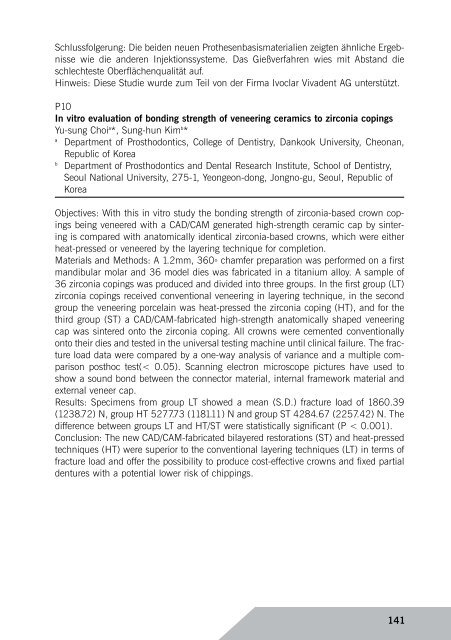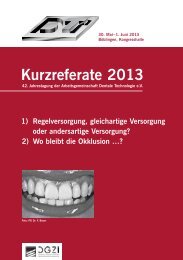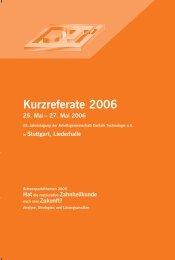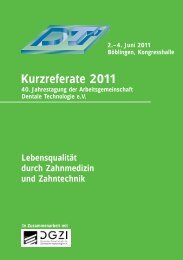VITA Easyshade® Advance – Irren war menschlich!
VITA Easyshade® Advance – Irren war menschlich!
VITA Easyshade® Advance – Irren war menschlich!
Erfolgreiche ePaper selbst erstellen
Machen Sie aus Ihren PDF Publikationen ein blätterbares Flipbook mit unserer einzigartigen Google optimierten e-Paper Software.
Schlussfolgerung: Die beiden neuen Prothesenbasismaterialien zeigten ähnliche Ergeb -<br />
nisse wie die anderen Injektionssysteme. Das Gießverfahren wies mit Abstand die<br />
schlechteste Oberflächenqualität auf.<br />
Hinweis: Diese Studie wurde zum Teil von der Firma Ivoclar Vivadent AG unterstützt.<br />
P10<br />
In vitro evaluation of bonding strength of veneering ceramics to zirconia copings<br />
Yu-sung Choi a *, Sung-hun Kim b *<br />
a Department of Prosthodontics, College of Dentistry, Dankook University, Cheonan,<br />
Republic of Korea<br />
b Department of Prosthodontics and Dental Research Institute, School of Dentistry,<br />
Seoul National University, 275-1, Yeongeon-dong, Jongno-gu, Seoul, Republic of<br />
Korea<br />
Objectives: With this in vitro study the bonding strength of zirconia-based crown copings<br />
being veneered with a CAD/CAM generated high-strength ceramic cap by sintering<br />
is compared with anatomically identical zirconia-based crowns, which were either<br />
heat-pressed or veneered by the layering technique for completion.<br />
Materials and Methods: A 1.2mm, 360◦ chamfer preparation was performed on a first<br />
mandibular molar and 36 model dies was fabricated in a titanium alloy. A sample of<br />
36 zirconia copings was produced and divided into three groups. In the first group (LT)<br />
zirconia copings received conventional veneering in layering technique, in the second<br />
group the veneering porcelain was heat-pressed the zirconia coping (HT), and for the<br />
third group (ST) a CAD/CAM-fabricated high-strength anatomically shaped veneering<br />
cap was sintered onto the zirconia coping. All crowns were cemented conventionally<br />
onto their dies and tested in the universal testing machine until clinical failure. The fracture<br />
load data were compared by a one-way analysis of variance and a multiple comparison<br />
posthoc test(< 0.05). Scanning electron microscope pictures have used to<br />
show a sound bond between the connector material, internal framework material and<br />
external veneer cap.<br />
Results: Specimens from group LT showed a mean (S.D.) fracture load of 1860.39<br />
(1238.72) N, group HT 5277.73 (1181.11) N and group ST 4284.67 (2257.42) N. The<br />
difference between groups LT and HT/ST were statistically significant (P < 0.001).<br />
Conclusion: The new CAD/CAM-fabricated bilayered restorations (ST) and heat-pressed<br />
techniques (HT) were superior to the conventional layering techniques (LT) in terms of<br />
fracture load and offer the possibility to produce cost-effective crowns and fixed partial<br />
dentures with a potential lower risk of chippings.<br />
141








